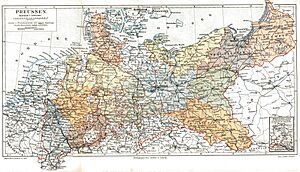Districts of Prussia facts for kids
Prussian districts were special areas used to organize land in the old Kingdom of Prussia. Think of them like a county or a shire in other countries. These districts were created between 1815 and 1818. They helped manage the land between the larger provinces and smaller local towns.
Prussian districts were an important part of the German Empire from 1871 to 1918. After that, they continued in the Free State of Prussia. The way these districts were set up became a model for the districts we see in Germany today.
Contents
What Were Prussian Districts?
Prussian districts were a type of administrative unit. This means they were areas created by the government to help manage a country. They were like a middle layer of government. They sat between the big provinces and the smaller towns and villages.
These districts helped the government keep things organized. They made sure laws were followed and services were provided. Each district had its own local administration. This helped manage daily life for people living there.
Why Were Districts Created?
Prussia became much larger after the Napoleonic Wars ended in 1815. The country needed a better way to manage its new territories. The old system was not working well for such a big area. So, new administrative units were needed.
The Prussian government decided to create these districts. They wanted to make sure that the government could reach all parts of the country. This new system helped to bring order and control to the different regions. It also made it easier to collect taxes and enforce laws.
How Were Districts Organized?
Each Prussian district was led by a special official. This official was called a Landrat. The Landrat was in charge of the district's administration. They worked closely with the local communities. They also reported to the higher provincial government.
The districts had specific responsibilities. These included things like keeping public order. They also managed roads and local schools. This system helped to make sure that local needs were met. It also ensured that the central government's rules were followed.
Districts in the German Empire
In 1871, the German Empire was formed. Prussia became the largest and most powerful state within this new empire. The Prussian districts continued to play a key role. They remained the main local administrative units.
During this time, the districts helped to carry out national policies. They were important for things like military conscription. They also helped with public health and education. The system proved to be very effective.
Districts After World War I
After World War I, the German Empire ended. The Free State of Prussia was established. The districts continued to exist. They still served as important administrative areas.
However, their role changed slightly. The new government aimed for more local self-governance. The districts adapted to these changes. They continued to manage local affairs until the 1930s.
Legacy: Modern German Districts
The system of Prussian districts had a lasting impact. It became a model for how local government is organized in Germany today. The modern districts of Germany (called Landkreise) are very similar. They perform many of the same functions.
This shows how old administrative ideas can still be useful. The Prussian districts helped shape the way Germany is governed. They created a strong foundation for local administration.


